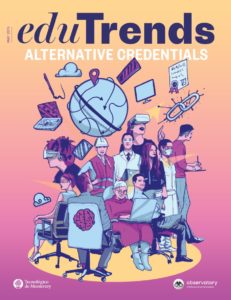eduTrends: Alternative Credentials
Einen guten Überblick über die neuen Währungen, die sich auf dem Bildungsmarkt breit machen, haben die Experten des Observatory of Educational Innovation aus Monterrey hier zusammengetragen (50 S.). Systematisch skizzieren sie zuerst die gesellschaftlichen Treiber („Vierte Industrielle Revolution“) und den daraus resultierenden neuen Blick auf Bildung und Lernen („from a four-year degree to a lifelong education“). Anschließend führen sie uns in den MOOC-Markt, mit etwas Geschichte und kurzen Profilen der großen Anbieter.

Das Herzstück dieser Studie bildet das Kapitel „What are Alternative Credentials?“ „Alternative credentials refer to the competencies, skills, and learning outcomes derived from assessment-based, non-degree activities and align to specific and timely needs in the workplace.“ (S. 24)
Die folgende Klassifikation umfasst drei Kategorien: 1) Labor Market Training and Credentialing, 2) MOOCs and Other Online Microcredentials, 3) Competency-Based Education Programs.
Es folgen Beispiele (vor allem) amerikanischer Hochschulen, die auf dem Markt alternativer Zertifikate bereits aktiv sind, sowie einiger Unternehmen wie IBM, die die Badge-Plattform von Acclaim einsetzen. Dann das obligatorische Kapitel über die Bedeutung der Blockchain sowie ein abwägender Ausblick. Ein ausführliches Literaturverzeichnis. Lesenswert.
„Education institutions with the ability to adapt to this new reality will stand out when faced with the imminent transformation of the world of training. The growing supply of alternative credentials must not be seen as a threat to traditional degrees; on the contrary, we hope that this transformation contributes to the evolution of degree programs and to remove access barriers. Traditional degrees and alternative credentials may and will have to coexist and learn from each other, strengthening learning opportunities for society.“ (S. 45)
Observatory of Educational Innovation, Tecnológico de Monterrey, Mai 2019
Nachtrag (31.05.2019): siehe auch „Why a New Kind of ‘Badge’ Stands Out From the Crowd“ (Goldie Blumenstyk, Chronicle of Higher Education, 30. Mai 2019)